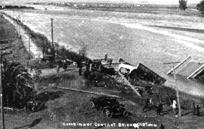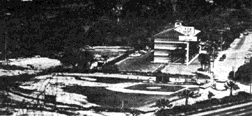
san diego river january 28, 1915

San Diego County is crisscrossed with river valleys, formed over the millennia by water winding its way through sandstone to the sea. These rivers are inconspicuous most of the time, dry beds and muddy trickles for the most part, except after winter rain storms. Then the water runs over the dry land and fills these pathways with tremendous force.
Mission Valley is a part of the 45 mile long San Diego River Valley,
an important watershed running from the Julian foothills to the sea.
The written history of Mission Valley begins in 1794 when Spanish
priests set up a mission in a place they called Nuestra Senora del
Pilar. They chose a spot in a valley near a large Kumeyaay village
called Nipawi. The current San Diego mission, surrounded by a forest of condos, was reconstructed in the early part of this century.

Until relatively recently Mission Valley remained largely
undeveloped. Just thirty years ago it was still a green valley
made up of pastures and fields, the Mission and a reformatory
school. Its bucolic past is largely due to its reputation as a flood
plain. In 1916 several days of rain following a drought created a
cataclysmic flood which carried buildings away in a surge of water
moving 70,000 cubic feet per second. The El Capitan dam, built in
1934, offers some control of the flow of water from mountains to the
ocean, but not enough to prevent another sizable flood in 1980
(27,000 cubic feet per second). The recent San Diego River
Improvement Project carved a flood-control channel through Mission
Valley, and installed flood water pumps, and dikes along the river.
Developers hope that these measures will accommodate any future
flood waters that may threaten the shopping centers, businesses,
residences, restaurants, theaters and hotels that are proliferating in
Mission Valley.

From an uninhabitable flood plain, Mission Valley has grown into a sprawling suburban mess built for one main purpose - the easy flow of vehicular traffic through a series of offices and shopping malls all built on a foundation of mud. This love affair with the automobile continues to expand the American mind/landscape's unending suburban fantasies, prompting the construction of malls in flood planes, golf courses in the deserts, and space stations in orbit. Mission Valley, in its short history of human habitation, has evolved from a circulatory system for water to a circulatory system for automobiles.